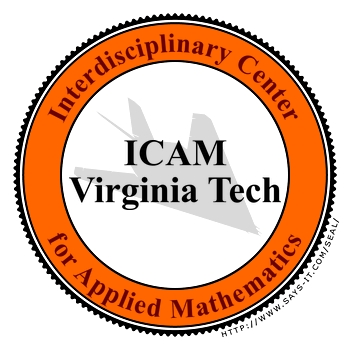






Quantum Monte Carlo (QMC) methods have a ubiquitous role in computational physics. The main cost of any QMC method, for example the variational Monte Carlo (VMC) method, is in constructing Slater matrices and in computing determinant ratios. Most of the recent physics papers discuss (and improve) only the scaling of constructing Slater matrices. In this talk we improve the scaling of computing the determinant ratios in the VMC method by using a preconditioned iterative solver. The most important contribution is in making the preconditioner work. Standard preconditioners don't work well because either the preconditioner does not exist or it is too expensive to compute and apply. To overcome these problems we perform two algorithmic improvements. The first involves cheap updates to the preconditioner exploiting the fact that the Slater matrix changes only by a row between two consecutive Monte Carlo steps. The second improvement involves a geometric reordering of particles and orbitals that increases the near-diagonal dominance of the Slater matrix. The cost of computing determinant ratios using our algorithm is O(n2) per sweep as compared to O(n3) per sweep using the traditional algorithms, where n is the system size and a sweep is an attempt to move each particle in the system once. The work described here was done in collaboration with my advisor, Eric de Sturler, as well as Bryan Clark, David Ceperley, and Jeongnim Kim.
The biologist's intuition is that genes that play similar roles in the cell have a closer relationship in higher expression values. A microarray machine measures the mRNA abundance in a gene and this mRNA reading is called the gene's expression value. When a gene is active in a role, the expression value will be high. When two genes are involved in the same role, or have the same function, they will be highly correlated. The genes should be even more correlated in the higher expression values because both genes are active in the role. I want to find out if this relationship is true. Are the genes more correlated in higher expression values or does it just appear to be that way? If the genes are not more correlated in higher values, how can we filter the expression values to find out how much genes correlate? During this research, I used different filtering methods to find out how to determine genes that are related to each other or have similar functions. I used genes that I knew were performed the same function and each gene had 1,776 expression values. The conclusion that I drew based on my findings is that the biologist's intuition about higher expression values is not exactly correct.
We present a flexible Finite Elements (FE) method that combines features of Immersed Finite Elements (IFE) with Discontinuous Galerkin (DG) methods for solving elliptic boundary value problems with discontinuous coefficients in 2D, without requiring the mesh to be aligned with the material interfaces. A main feature of IFE is to allow using structured meshes and to give a flexibility for mesh refinement. The use of a DG formulation for the IFE method ensures the optimal rate of convergence in the L2 and H1 norms, under h-refinements. The main goal here is to present a Quadratic IFE space in which numerical solutions are able to optimally represent the non-smooth behavior of the solution across the interfaces without requiring the mesh to be aligned with the discontinuity. Different interface jump conditions are employed and justified. Numerical results (for interface problems with structured mesh and mesh refinement) are presented and discussed to illustrate features of these DG-IFE. A proof for the existence and uniqueness of the quadratic immersed shape functions is presented, as well. This talk represents joint work with professor Tao Lin and my advisor professor Slimane Adjerid.
Amblyomma americanum, the Lone Star tick, is the predominant tick species throughout the southeast United States. Its importance has grown over the past few decades as its role in disease transmission was recognized and as ehrlichiosis cases have risen. The key to Lone Star tick control begins with an understanding of its complex three-host life cycle and continues long term with successful management of the tick on its primary host, the white-tailed deer. Here we formulate a discrete temporal model of the tick life cycle in order to investigate the optimal spatial arrangement of 4-poster feeders within the Fairfield Glade retirement community. Our model includes the distinct life stages of this tick population and the spatial features of this community. Data collected by J. Harmon (unpublished) are used to estimate some of the parameters while others are based on previous Lone Star tick modeling work by Haile and Mount (1987). We formulate an economic criterion to evaluate various feeder placement scenarios that allow recommendations to be made to Fairfield Glade for 4-poster feeder arrangements that minimize both cost and ehrlichia cases and that tend toward future projects in optimization of this system.
Under a mild mesh restriction, $(X_h,Q_h)=(P_k,P_{k-1}^{disc})$ element pairs have recently been shown to be inf-sup stable for $k\ge d$. Since $\nabla \cdot X_h \subset Q_h$, the usual weak mass conservation equation implies strong mass conservation, which has several important consequences. In this talk, we will compare NSE simulation results of this element pair against those obtained from more commonly used element pairs.
A model, which describes Photosynthetic Carbon Metabolism, consists of a system of nonlinear ordinary differential equations (ODE's). Although identification of parameters in these 20 linked ODE's is ultimately needed, we focus on the collocation method to solve the system of ODE's as an intermediate stage for Parameter Estimation. The collocation procedure is simple, while it solves the complicated system of ODE's.
(Kevin Harris was unable to attend the conference and had to cancel his talk.)
The NCAA uses the knockout tournament for determining the best Division 1 college basketball team. The goal of such a design is to identify the overall best team, but imperfect seeding and chance events sometimes cause weaker teams to advance, while stronger teams get eliminated. The problem of pairing teams can be formalized using Bayesian methods for creating new designs. Starting with the Bradley-Terry model for paired comparisons, we develop a method for pairing teams in each round that does not depend as much on initial seeding.
Difficulty arises in rigid multibody dynamics for convex polyhedral bodies when non-interpenetration constraints are enforced. To calculate normal vectors at contact, it is necessary to determine the amount of penetration, when it exists. The classical computation of the depth of penetration when applied to convex polyhedral bodies is inefficient. We will construct a signed distance function and implement it for use with a method for achieving geometrical constraint stabilization for a linear-complementarity-based time-stepping scheme for rigid multibody dynamics with joints, contact, and friction which, before now, was not equipped to handle polyhedral bodies.
The optimal sensor placement for purposes of feedback control is vital in order to obtain information necessary for accurate state estimation. A method for sensor placement for the heat equation in two dimensions is discussed. In particular, we show how feedback functional gains reflect spatial regions over which accurate information is paramount for control. We use this information in an algorithm which computes Centroidal Voronoi Tessellations, yielding optimal locations for sensors.
The deconvolution problem is an important inverse problem. Given a blurred signal, we would like to obtain the original. This problem gets more complicated when noise is added to the signal, as the problem is ill-conditioned. This talk will focus on the differential filter operator.
In this presentation we construct simple, efficient and asymptotically correct a posteriori error estimates for discontinuous finite element solutions of three-dimensional scalar first-order hyperbolic partial differential problems on tetrahedral meshes. We explicitly write the basis functions for the error spaces corresponding to the finite element space Pp. The leading term of the discretization error on each tetrahedron is estimated by solving a local problem. The a posteriori error estimates are tested on several linear problems to show their efficiency and accuracy under mesh refinement for smooth solutions.
In this talk, we will formulate a parabolic parameter estimation problem. This includes storing the necessary conditions for optimality. One of these conditions includes the Frechet derivative, of the state equation with respect to parameter variations. We will outline our future strategy for computing this derivative, and present some preliminary results.
Solving stochastic partial differential equations is of current interest. For example, the modeling of groundwater flow requires information about subsurface properties including porosity and permeability which are represented by random variables in the SPDE. The current methods for solving such problems require either new code (stochastic finite element methods), the execution of legacy code a large number of times (Monte Carlo methods), or strict smoothness assumptions of the solution space (sparse grid methods). I will present an adaptive interpolation method that utilizes legacy code, does not require the solution space to be smooth and aims at keeping the number of function evaluations low.
We will address the optimal filtering problem for distributed parameter systems when the measurements are given by stationary and mobile sensor networks. The problem will be formulated as an optimal control problem with constraints concerning the minimization of the trace of the solution to a Riccati equation. We will give general conditions for the solution to the Riccati equation to belong to the Schatten operator classes (Trace Class, Hilbert-Shcmidt, etc) and will introduce a Galerkin scheme together with a gradient type algorithm to approximate the optimal solution for the problem. We will show 1D and 2D examples.
We consider the mathematical formulation, analysis and numerical solution of an optimal control problem associated with the tracking of the velocity of a Navier-Stokes/Brinkman model. An application of this model is wind turbine micrositing. We prove the existence of optimal solutions, as well as the first order necessary conditions of optimality, deriving an optimality system of PDEs whose solutions provide optimal states and controls. Semidiscrete-in-time approximation and their convergence to exact optimal solutions is also shown.
(?Abstract?)
One of the main hurdles in the development of modern closure models in Proper Orthogonal Decomposition (POD) of turbulent flows has been the lack of efficient computational strategies for the discretization of the associated nonlinearities. We introduce a two-level discretization methodology that reduces dramatically the computational cost, without compromising the accuracy of the model. This is demonstrated numerically in the 3D simulation of a flow past a cylinder at Re=1,000. This talk discusses work done in collaboration with Imran Aktar, professor Jeff Borggaard, and my advisor professor Traian Iliescu.
This talk presents a study of stabilization techniques (of grad-div type) for use with the recently proposed energy and helicity conserving scheme for the Navier-Stokes Equations (NSE). Since this scheme uses a Bernoulli pressure, stabilizations are necessary; however, these can alter the discrete physics that the scheme was designed to preserve. We show how an alteration of the usual grad-div stabilization can reduce the effect of the Bernoulli pressure error on the velocity, with less effect on important physical quantities than the usual grad-div stabilization.
A Centroidal Voronoi Tessellation (CVT) is a Voronoi tessellation of a region whose generating points are also the mass centroids of the corresponding Voronoi regions. Centroidal Voronoi tessellations have diverse applications in many areas of science and engineering. In this talk, we discuss acceleration of the classic iterative algorithm for computing CVT's, the Lloyd Method, by applying over-relaxation schemes in the iteration process. Optimal choices of the over-relaxation parameter are studied theoretically. We also verify our results and show faster convergence of the proposed over-relaxed Lloyd method through various numerical experiments in one and two dimensions.
We will discuss an application of p-th degree immersed finite elements (IFE) to the moving interface problems of parabolic equations with discontinuous coefficients. The interface jump conditions are employed in the IFE functions, and the mesh need not be aligned with the location of interface. Thus, we can solve the problem on a fixed mesh even though the interface is moving. A fully discretized scheme based on the Crank-Nicolson method will be presented. Optimal error estimates for this scheme have been obtained and numerical examples will be presented to illustrate the performance of this scheme.
You can return to the SIAM Student Conference 2010 web page.